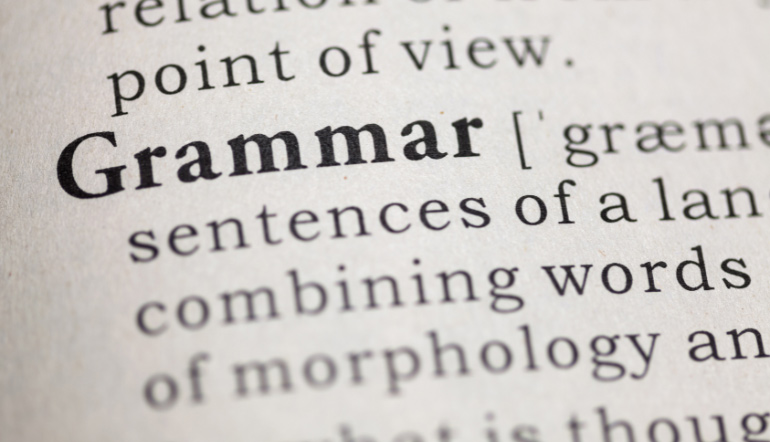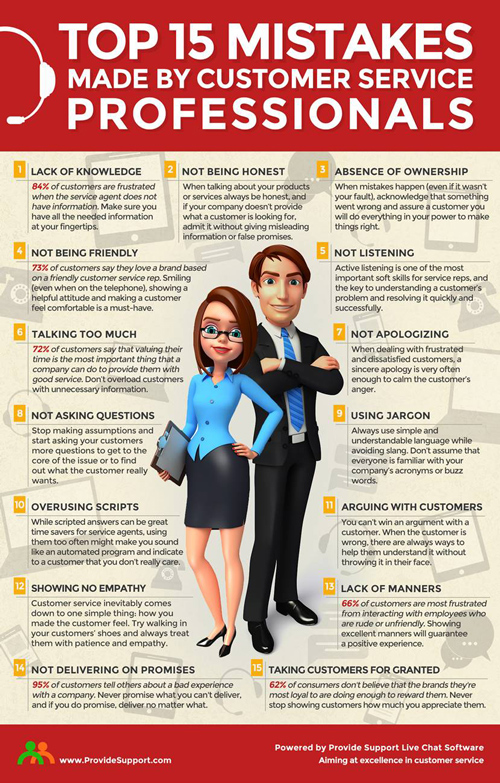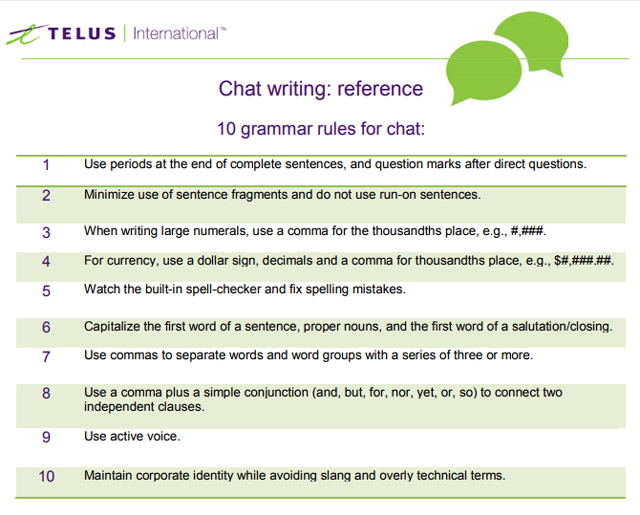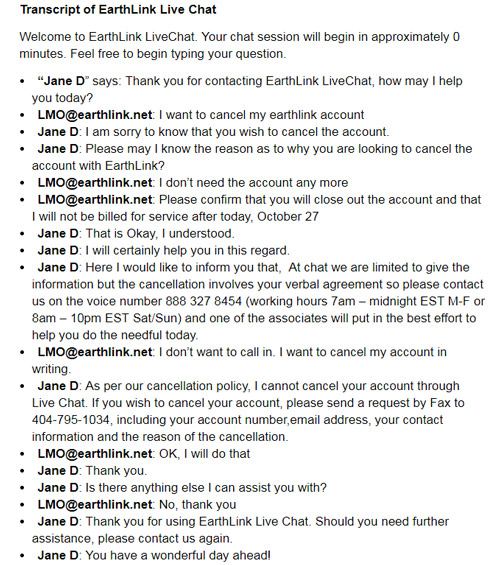
So far you’ve learnt how to properly greet the customers and how to chat to them when providing support over live chat.
You’re also aware that live chat is a tool that replaces the voice in a conversation (e.g. via phone) but enables a customer to get a faster support and help as if they were actually speaking to the CSR, which is much faster than writing (e.g. emailing the company).
However, Zendesk’s article 6 Best practices for chat etiquette in its introduction reminds you that communicating over live chat can be different than interacting with a customer in person, on the phone, or over email.
Sometimes, customers can misunderstand what you’re trying to say because communicating through text can leave more room for interpretation.
Then, how should you communicate with people via live chat? The same as when you’re speaking i.e. more conversationally?
Or should you remain professional as if you were writing a business email?
That’s the topic we’re going to focus on in this lesson.
It greatly depends on customers’ expectations, so that will be our starting point.
How Customers Generally Expect Csrs to Communicate Over Live Chat
You‘ve been a customer at least once in your lifetime, right? Then, you’ll better understand the point if you first think of your own experience.
When you start a conversation with a professional company, what are you expecting? Think about that!
What are your expectations from a high-end company if you chat to them? Expecting misspellings and slackness?
Or are you expecting a pretty high-quality conversation? Responsiveness?
Are you expecting the company’s CSR to be warm and friendly or cold and distant?
Are being warm and professional mutually exclusive? Can a CSR be friendly and professional at the same time?
That’s exactly what we’re all expecting from CSRs, isn’t it? The perfect balance between professionalism and friendliness.
However, the problem occurs when CSRs start being overly familiar, almost flirty instead of professional.
So, don’t get slack!
Remember – being friendly is OK but beware of crossing the fine line and becoming super friendly in an inappropriate way.
AVOID getting too conversational.
Rather remain pleasant but professional. Don’t forget that you’re NOT chatting with your friends and family members, BUT speaking on behalf of your employer i.e. a company.
Take a glance at the infographic Top 15 Mistakes Made By Customer Service Professionals.

Have you noticed how your communication habits can impact customers’ satisfaction and loyalty?
But how do you know if you’ve crossed the line? And what does it mean to keep your live chat conversations highly professional?
Let’s talk about that now.
How to Keep a Live Chat Conversation Professional
When providing a live chat support to customers, this is how you’ll make sure that you’re retaining a high level of your conversations (from the language aspect):
- Mind your grammar
- Avoid making spelling mistakes
- Use the punctuation properly (capital letters, full stops, commas etc.)
- Mind your sentence structure
In other words, make sure you speak really well. Also, write as you speak in that case. That’s what inherently creates that professional aspect of your live chat conversation.
As pointed out in Unforgivable Spelling Errors—And How to Avoid Them, you must spell the bread-and-butter words of your profession correctly.
Don’t hesitate to pay closer attention to the article and learn from it.
What’s more, Copyblogger assembled 15 most egregious grammar goofs into one helpful infographic. With this handy reference, you’ll never look silly again.

Also, here are some basic rules to follow in your live chat conversations:

Here are some general points emphasized in the training for online chat agents linked above:
- Agent responses in the chat environment should adhere to most grammar rules.
- Agents should keep conversations short and on point.
- Agents should provide the most important information at the beginning of responses.
- Agent writing skills can significantly impact customer effort; muddled responses with poor grammar and punctuation impact the velocity of chat.
- Agents should know, and be expected to convey, the company’s voice/tone and use the appropriate amount of personalization.
Good grammar is important for all of these reasons — precise sentences are easy to read. Writing that is peppered with misspellings, confusing acronyms and grammatical mistakes not only confuses the reader but also calls into question the credibility of the information.
Using good grammar — especially punctuation and capitalization — enhances the level of professionalism and minimizes confusion. Agents require training on basic writing skills to ensure a consistent, positive customer experience.
That’s basically the whole point.
Don’t you find these insights precious? Imagine how much you’ll learn when you go through the guide thoroughly and pay attention to details.
Now, let’s explore some more credible sources for you to learn from and develop exceptional language skills necessary for your future online job and prosperous CSR career. Ready?
Everyone in the modern world knows how to chat online. Still, not everyone can work as a customer service chat operator. Professional communication differs from any personal chat. The article 7 Basic Rules for Customer Service Chat Operators will also help you sound professional when chatting with clients.
English, like many other languages, has its own set of tricky rules and intricacies. But with a little bit of practice and help from guides like this one, you can become a grammar master.
Thus, don’t hesitate to check out the most common grammar mistakes Hubspot’s picked up on in their article Grammar Police: 30 of the Most Common Grammatical Errors We All Need to Stop Making.
Besides the first guide we mentioned above, The Importance of Good Grammar in Customer Service Chat further suggests William Strunk’s “The Elements of Style” as a great place to start when it comes to learning how a sentence works.
Strunk’s short guide takes a prescriptive approach to grammar in which brevity is praised. The guide features an excellent section on the elementary rules of usage that breaks down sentence structure in 11 short and easy to understand guidelines that will help you to form sentences.
Go ahead – follow the links to these valuable sources, learn and have some fun.
Here are a few other helpful sources mainly discussing common language mistakes for you to refer to when you start perfecting your grammar:
Of course, you can explore more grammar topics by visiting the website with Grammar Girl’s tips.
And once you’re satisfied with what you’ve learnt, you may want to check your knowledge. Online Grammar and Spelling Quizzes: Are You Smarter Than an 11th Grader? offers plenty of wonderful sources where you can test your language knowledge.
Go ahead! Have fun!
Feel a bit tired of grammar and rules? Let’s take a break, then, and move on to another topic of our interest in this lesson.
Wondering WHY impeccable language and communication skills are so significant for you as a future CSR? Keep reading and find out.
Why Should You Mind Every Word You Use in Your Live Chat Conversations?
As argued in The Importance of Good Grammar in Customer Service Chat quickness of reply and efficiency of work may be conflicting interests. It is important to make sure that you are as clear as possible when corresponding with a customer.
Taking a few extra seconds to ensure that you are using complete sentences and placing your subjects and predicates in the right places can help to ensure that the customer understands what you are saying.
It also presents you and your company in the best light possible to the customer in terms of professionalism and customer service.
Engaging in live chat sessions with customers and visitors is a lot different than chatting with friends and family on Facebook or instant messenger applications. Although the process is very similar, the rules are what make the two types of chat very different.
When chatting with friends and family on an instant messenger application, you may not place too much emphasis on capitalization, spelling, and grammar – this is acceptable as long as you’re chatting in an informal environment.
However, when you are representing your brand or company in a chat session, you must always present yourself (and the company) in a professional manner by ensuring that you avoid grammatical errors and typos.
That’s why The Guide to Becoming a Top Performing Live Chat Agent advises you to be careful with grammar and always take an extra second or two to review your chat responses before clicking “Send” or pressing on the “Enter” key.
This will help prevent embarrassing errors that do not reflect well upon yourself as an agent, or the company you represent.
Similarly, as pointed out in 10 Spot On Rules Of Etiquette For Live Chat Success!, a customer support agent with bad grammar or spelling will indicate to the customer that the company doesn’t value them and will make the entire business seem unprofessional.
That’s why these experts advise you not to use internet speak (such as “lol” or “brb”), shorthand, or type in all caps (which may indicate that the agent is shouting). Also, jargon or technical terms should be kept to a bare minimum to prevent the customer from becoming confused.
Another source, Are You Making These 25 Webchat Mistakes?, states the same facts. Here’s what they say.
Although less formal language can be used in webchats, it is important that agents use webchat in a professional and knowledgeable manner.
Bad grammar, spelling and over-familiarity can reflect badly on your company.
And here’s what they say about responding to customers with lengthy and complex answers.
Unlike phone calls, where people invariably remain on the line, customers can often become distracted during a webchat, switching between browser windows and doing other online activities.
Therefore ensure that your responses are short and concise to retain the customer’s attention. By the same token, webchat should not be too complicated. Intricate, long-winded procedures will frustrate the customer.
Not convincing enough reasons for you? Here’s more.
It’s critical for you to keep in mind that chat text is recorded for posterity.
Not only does it mean that your team members or newbies will perhaps learn from your real example conversations, BUT it means that your employer can look through your chat transcripts any time and see what you’ve been saying to customers.
Yes, that’s what employers often do!
They want to make sure you’re doing your job right. If so, they want to use your high-quality professional conversations to teach future CSRs in the team.
Thus always remain professional and mind your language! If you do that, you’re bound to succeed.
The following subsection will hopefully provide a better insight into what to do and what to avoid by presenting some real-life examples of live chat conversations.
Real-Life Examples of Live Chat Conversations With Good and Bad Use of Language
Let’s briefly analyze a few examples of live chat scripts where mistakes were made and compare them with some decent examples so that you learn from both.
First, take a look at a real-life example of a live chat conversation where the CSR used unusual phrasing.

To find out what was so odd in this agent’s wording and how it affected the chat and the customer’s satisfaction, thoroughly read the full article “Doing the needful”? Does odd wording harm the quality of customer service chat?.
You see how important your sentence structure is? Make sure it’s not awkward.
Let’s continue with an example of the CSR’s excessive use of exclamation marks.

For further analysis of this example, refer to the full article Are 6 exclamation points too many? Punctuation’s gone wild in live chat with Crate and Barrel.
The example below illustrates the lack of proper capitalization. Notice that the agent does not capitalize the first word in any of his responses.
As for spelling, notice the word “checked” in the third agent response. It is spelled correctly, but improperly used. The meaning is still clear, yet it causes the reader to pause to confirm the information.
Customer: Hi, looking at product code 6X999-DPPCDU1, the catalog says it comes with a i7 overclocked to 3.36Xor $1499 but when I enter that, it comes with a 2.8ghz overclocking costs an additional $499.
Agent: i am glad you chatted with us today and i am happy to check that out for you
Customer: actually additional $399
Agent: the product code that you were looking at comes with i7 however, up to 2.8 ghz only
Customer: I can see that, but that is NOT what the catalog I received says
Agent: i will double checked on that. is it a July catalog?
Customer: Everything else is correct. It is from page 30, yes July
Customer: first thing listed is “Overclocked Interl Core i7 (3.36GHz, 8MB Cache)
Agent: kindly give me a couple of minutes to further check it
Customer: Take your time and thank you.
Agent: you are welcome. one moment please.
Agent: thank you for patiently waiting.
Agent: we do apologize for the inconvenience, however there is just a website error.i suggest you check back an hour or two as we are currently fixing it
Customer: excellent. Thanks.
Using commas with simple conjunctions to join two independent clauses (clauses to be emphasized equally) aids readability. The agent’s comment below properly uses a comma with a simple conjunction (in this case but) to create a clearly worded and professional response.
Agent: It sounds like it could be one of several issues, but I am unfortunately not equipped to diagnose the problem you are experiencing.
The following run-on sentence uses no commas to separate thoughts an forces the customer to slow down to decipher meaning.
Agent: I believe they do but if they do not. you can print out the steps on the manual which is available online so you will not have difficulty on installing them.
A better way to construct this sentence is:
I believe they do, but if they do not, you can print out the steps in the manual, which is available online, so you will not have difficulty installing them.”
This agent response is still awkward, but using commas properly with the conjunctions allows the customer to easily understand the agent’s intent.
Now, let’s show how it should be done. Take a closer look at an example of a CSR using a friendly, conversational tone but keeping the live chat conversation professional (taken from: Leslie O’Flahavan – Ewrite webinar – Slideshare: 5 ways to write great chat).

Compared it to the previous bad examples?
You see the difference? Got the point now? Undoubtedly.
We couldn’t agree more with what’s been written in the article 10 Writing Skills Agents Need to Chat With Customers. You’d want to take a peek at it, but here are some highlights regarding the language use…
While chat is certainly less formal than other types of writing, spelling mistakes and punctuation errors never improve communication. You certainly don’t have to write standard, formal sentences in a fast-paced chat, but you should spell words and use apostrophes correctly.
Bloopers like these make your company look bad and your service questionable:
- Whats the start and end date of your trip?
- We will be glad to assist you and Ship your items to Toronto Canada
- Currently, we are experiencing the technical glitch in our system…
Keyboarding errors like these are not as bad, though it’s best to avoid them too:
- I am glad I was able to assist you today.
- Once you’re done, click on the “Continue” button.
- You have a wonderful day ahead!
Also, as pointed out in 7 writing skills you’ll need to please customers, chat and sometimes email are less formal than other forms of writing. But they’re still a professional exchange and should be treated as such.
Standard, formal sentences aren’t necessary in a fast-paced chat, but proper spelling and punctuation is a must for clarity.
That’s why honing your language skills is imperative in order to communicate with customers clearly, concisely and courteously.
Bear in mind that using proper grammar and sentence structure will enable you to solve the customers’ issues rapidly, as well as to avoid confusion and possible misunderstandings that occur in online written communication.
So, let’s put all your learnings from this lesson in a nutshell now.
In Summary
Always remember to watch your language when providing customer support via live chat. Keeping your writing polished is a way to demonstrate your professionalism.
How do you get across that you’re professional in terms of language use?
Simply by perfecting your grammar skills and sentence structure, avoiding spelling mistakes, and using punctuation (capitals, full stops, commas, question marks etc.) properly.
The Importance of Good Grammar in Customer Service Chat states that chat representatives who combine brevity and personalization with proper sentence structure will see success in the form of happy customers with quality answers to their questions.
So they advise you to take the time to come up with a brief and effective response by following a few simple grammar guidelines. It is better to take extra time to make sure that your response makes sense than to send one that might create more confusion, right?
All in all, follow these simple rules if you want to appear professional and get or keep your job, and don’t miss the opportunity to learn from all the credible and relevant sources suggested in the lesson.
Now it’s only left for you to test your knowledge by taking our quiz and to apply it in your CSR work. Best of luck!
Frequently Asked Questions
1. How should a CSR communicate with customers over live chat?
a. Clearly
b. Concisely
c. Courteously
d. Friendly but professionally
e. All of the above
2. Why is honing your language skills imperative in live chat customer service?
a. Because using proper grammar and sentence structure will enable you to solve the customers’ issues efficiently
b. Because adequate language skills can help to ensure that the customer understands what you are saying i.e. to minimize or avoid confusion and possible misunderstandings that occur in online written communication
c. Because using good grammar enhances the level of professionalism and ensures a consistent, positive customer experience
d. Because muddled responses with poor grammar and punctuation impact the velocity of chat
e. Because writing that is peppered with misspellings, confusing acronyms and grammatical mistakes not only confuses the reader but also calls into question the credibility of the information
f. Because a customer support agent with bad grammar or spelling will indicate to the customer that the company doesn’t value them and will make the entire business seem unprofessional
g. Because chat text is recorded and your employer can look through your chat transcripts any time and see what you’ve been saying to customers. What’s more, they can use real examples of your chat conversations to teach future team members. So, not being professional can leave you jobless
h. All of the above
3. Experts advise you…
a. Not to use common Internet abbreviations, jargon or technical terms to prevent customers from becoming confused
b. To type in all caps so that your customers can better see every single detail in your messages
4. Responding to customers with lengthy and complex answers is…
a. highly advisable because you can save your precious time by presenting all the necessary information to the customer in only one message.
b. what you should not do because customers find it quite frustrating since they can often become distracted during a webchat (switching between browser windows and doing other online activities). So, ensure that your responses are short and concise to retain the customer’s attention.
5. TYPING IN ALL CAPS usually indicates that…
a. You want the recipient to pay attention to all the details in your message.
b. You consider the message to be of high importance.
c. You are shouting.
6. The contractions “e.g.” and “i.e.” have the same meaning.
a. Yes and you can use them interchangeably.
b. No, “e.g.” means “for example”, whereas “i.e.” roughly means “in other words”.
c. Who cares?! You shouldn’t because you’re not studying to become a novelist or a copywriter but a CSR.
7. Which part of speech is the word “respond”?
a. Article
b. Adjective
c. Noun
d. Verb
8. Which part of speech is the word “customer”?
a. Adverb
b. Preposition
c. Pronoun
d. Verb
e. Noun
9. Which of the following words is an adverb?
a. Efficient
b. Because
c. Expertly
d. Defusing
e. Chat
10. Which of the following sentences is grammatically correct?
a. David always handles our customers’ complaints expertly and efficiently
b. David always expertly and efficient handles our customer’s complaints
11. Which of the following sentences is grammatically correct?
a. You’re customer service is brilliant!
b. Your customer service is brilliant!
12. Which of the following sentences is grammatically correct?
a. After declining for months, Jean tried a new tactic to increase ROI
b. Jean tried a new tactic to increase ROI after it had been declining for months
13. In the sentence “Our store website got ___ visitors last week ___ last month.” the correct missing word combinations are:
a. Less, than
b. Less, then
c. Fewer, then
d. Fewer, than
14. Short “Yes” or “No” answers sound a bit rude. Also, polite live chat operators don’t usually use “yep” and “nope” words at work.
a. True. Instead, they should write something like: “Yes, it is”, “No, that’s not exactly how it works”, “Yes, I will help you with it”
b. False. Besides, the exact words do NOT matter as long as they provide customers with factually correct information
